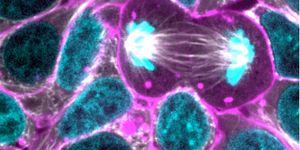All of the information needed for building an organism is contained within its genome, present in every cell. When new proteins are required, the genetic information that encodes for it is transcribed into messenger RNA (mRNA), which acts as a blueprint that the cellular machinery uses to translate the mRNA into a protein. The mRNA undergoes a number of processing events after transcription. A molecular machine called the spliceosome removes non-coding portions called introns from the transcript. The mRNA can undergo a huge number of additional modifications after it is translated from the genome, some of which can have a huge impact on the kind of protein it makes. One type of modification that has that effect is alternative splicing, a mechanism that edits the mRNA so that the original genetic code can result in the production of different proteins.
One gene that undergoes such alternative splicing is Fas, also called APO-1. The proteins that are made from the Fas gene after different splicing events either promote or prevent apoptosis – a mechanism of controlled cell death.
New research published in eLife and led by Professor Michael Sattler, Director of the Institute of Structural Biology (STB) at Helmholtz Zentrum München has revealed more about Fas splicing and how an RNA-binding protein called RBM5 impacts it. He discusses the work in the short video above.
"The right balance between these opposing results is dependent on the cell type and can also lead to uncontrolled cell growth and cancer when alternative splicing is disregulated," explained Sattler. His team worked in collaboration with a group led by Professor Juan Valcárcel Juárez at the Centre de Regulació Genòmica (CRG) in Barcelona, and they have learned more about the splicing process and how it leads to different forms of the protein, called isoforms, of Fas.
"The focus of our interest was the protein RBM5, which often exhibits mutations in lung tumors," said Dr. André Mourão of the STB. "RBM5 helps to bring the spliceosome to the mRNA by binding to a spliceosomal protein,” explains coauthor Dr. Sophie Bonnal of the CRG Barcelona. The researchers determined that RBM5 controls the balance betweem the isoforms, selecting the isoform of Fas that ends up being expressed.
"By employing nuclear magnetic resonance (NMR) spectroscopy at the Bavarian NMR Center in Garching, we were able to elucidate the spatial structure of RBM5-OCRE in complex with SmN (a protein present in the spliceosome) and to understand exactly how these interaction occurs," staid Sattler.
When the researchers mutated the protein regions required for the interaction, the splicing abilities of RBM5 were disrupted when analyzed in a cell culture model. In a test tube, the mutated proteins no longer interacted; their hypothesis was confirmed.
"The process of alternative splicing affects numerous essential functions and processes in an organism, and disregulation can trigger cancer. That is why it is very important to precisely understand the mechanisms that regulate these processes," Sattler concluded.
The authors would like to explore RBM5 further to figure out exactly how it is binding RNA, as well as whether it interacts with other parts of the spliceosome. If you want to know more about how the spliceosome impacts mRNA, watch the following video.
Sources:
AAAS/Eurekalert! via
Helmholtz Zentrum München,
eLife









